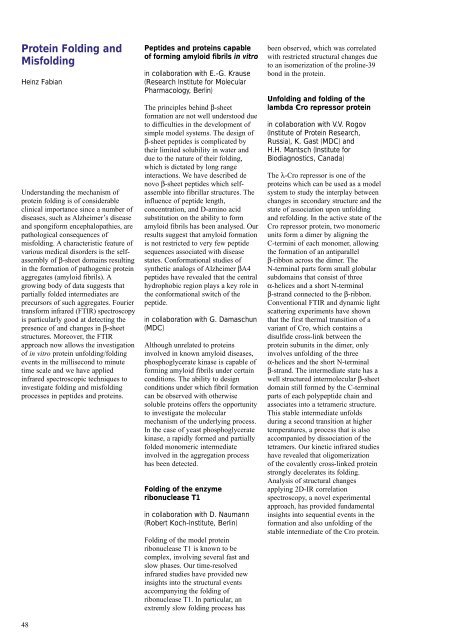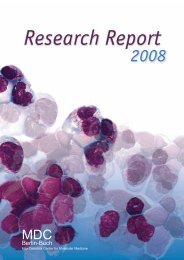Create successful ePaper yourself
Turn your PDF publications into a flip-book with our unique Google optimized e-Paper software.
Protein Folding and<br />
Misfolding<br />
Heinz Fabian<br />
Understanding the mechanism of<br />
protein folding is of considerable<br />
clinical importance since a number of<br />
diseases, such as Alzheimer’s disease<br />
and spongiform encephalopathies, are<br />
pathological consequences of<br />
misfolding. A characteristic feature of<br />
various medical disorders is the selfassembly<br />
of β-sheet domains resulting<br />
in the formation of pathogenic protein<br />
aggregates (amyloid fibrils). A<br />
growing body of data suggests that<br />
partially folded intermediates are<br />
precursors of such aggregates. Fourier<br />
transform infrared (FTIR) spectroscopy<br />
is particularly good at detecting the<br />
presence of and changes in β-sheet<br />
structures. Moreover, the FTIR<br />
approach now allows the investigation<br />
of in vitro protein unfolding/folding<br />
events in the millisecond to minute<br />
time scale and we have applied<br />
infrared spectroscopic techniques to<br />
investigate folding and misfolding<br />
processes in peptides and proteins.<br />
48<br />
Peptides and proteins capable<br />
of forming amyloid fibrils in vitro<br />
in collaboration with E.-G. Krause<br />
(<strong>Research</strong> Institute for Molecular<br />
Pharmacology, Berlin)<br />
The principles behind β-sheet<br />
formation are not well understood due<br />
to difficulties in the development of<br />
simple model systems. The design of<br />
β-sheet peptides is complicated by<br />
their limited solubility in water and<br />
due to the nature of their folding,<br />
which is dictated by long range<br />
interactions. We have described de<br />
novo β-sheet peptides which selfassemble<br />
into fibrillar structures. The<br />
influence of peptide length,<br />
concentration, and D-amino acid<br />
substitution on the ability to form<br />
amyloid fibrils has been analysed. Our<br />
results suggest that amyloid formation<br />
is not restricted to very few peptide<br />
sequences associated with disease<br />
states. Conformational studies of<br />
synthetic analogs of Alzheimer βA4<br />
peptides have revealed that the central<br />
hydrophobic region plays a key role in<br />
the conformational switch of the<br />
peptide.<br />
in collaboration with G. Damaschun<br />
(<strong>MDC</strong>)<br />
Although unrelated to proteins<br />
involved in known amyloid diseases,<br />
phosphoglycerate kinase is capable of<br />
forming amyloid fibrils under certain<br />
conditions. The ability to design<br />
conditions under which fibril formation<br />
can be observed with otherwise<br />
soluble proteins offers the opportunity<br />
to investigate the molecular<br />
mechanism of the underlying process.<br />
In the case of yeast phosphoglycerate<br />
kinase, a rapidly formed and partially<br />
folded monomeric intermediate<br />
involved in the aggregation process<br />
has been detected.<br />
Folding of the enzyme<br />
ribonuclease T1<br />
in collaboration with D. Naumann<br />
(Robert Koch-Institute, Berlin)<br />
Folding of the model protein<br />
ribonuclease T1 is known to be<br />
complex, involving several fast and<br />
slow phases. Our time-resolved<br />
infrared studies have provided new<br />
insights into the structural events<br />
accompanying the folding of<br />
ribonuclease T1. In particular, an<br />
extremly slow folding process has<br />
been observed, which was correlated<br />
with restricted structural changes due<br />
to an isomerization of the proline-39<br />
bond in the protein.<br />
Unfolding and folding of the<br />
lambda Cro repressor protein<br />
in collaboration with V.V. Rogov<br />
(Institute of Protein <strong>Research</strong>,<br />
Russia), K. Gast (<strong>MDC</strong>) and<br />
H.H. Mantsch (Institute for<br />
Biodiagnostics, Canada)<br />
The λ-Cro repressor is one of the<br />
proteins which can be used as a model<br />
system to study the interplay between<br />
changes in secondary structure and the<br />
state of association upon unfolding<br />
and refolding. In the active state of the<br />
Cro repressor protein, two monomeric<br />
units form a dimer by aligning the<br />
C-termini of each monomer, allowing<br />
the formation of an antiparallel<br />
β-ribbon across the dimer. The<br />
N-terminal parts form small globular<br />
subdomains that consist of three<br />
α-helices and a short N-terminal<br />
β-strand connected to the β-ribbon.<br />
Conventional FTIR and dynamic light<br />
scattering experiments have shown<br />
that the first thermal transition of a<br />
variant of Cro, which contains a<br />
disulfide cross-link between the<br />
protein subunits in the dimer, only<br />
involves unfolding of the three<br />
α-helices and the short N-terminal<br />
β-strand. The intermediate state has a<br />
well structured intermolecular β-sheet<br />
domain still formed by the C-terminal<br />
parts of each polypeptide chain and<br />
associates into a tetrameric structure.<br />
This stable intermediate unfolds<br />
during a second transition at higher<br />
temperatures, a process that is also<br />
accompanied by dissociation of the<br />
tetramers. Our kinetic infrared studies<br />
have revealed that oligomerization<br />
of the covalently cross-linked protein<br />
strongly decelerates its folding.<br />
Analysis of structural changes<br />
applying 2D-IR correlation<br />
spectroscopy, a novel experimental<br />
approach, has provided fundamental<br />
insights into sequential events in the<br />
formation and also unfolding of the<br />
stable intermediate of the Cro protein.

















